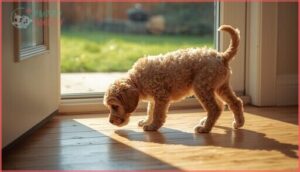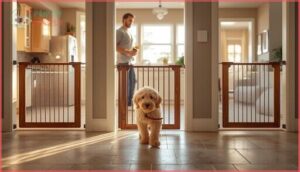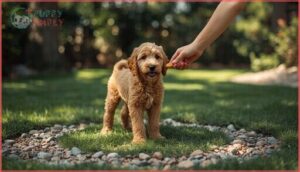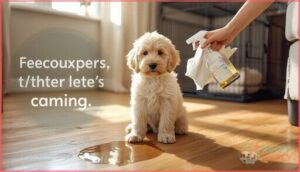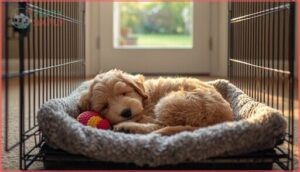This site is supported by our readers. We may earn a commission, at no cost to you, if you purchase through links.
You bring home your fluffy Goldendoodle puppy, and within the first hour, you realize you’re on a timeline. That adorable ball of curls can’t hold their bladder for long, and every carpet in your house suddenly feels like a target.
Most Goldendoodle puppies take four to six months to master potty training, though you’ll likely see real progress by the three-month mark. The timeline isn’t set in stone—some pups catch on in weeks while others need patience well past the half-year point.
Your puppy’s age, your consistency, and how quickly you learn to read their signals all play a role in how fast they go from accident-prone to reliably house-trained.
Table Of Contents
- Key Takeaways
- Potty Training Timeline for Goldendoodles
- Best Age to Start Potty Training
- Creating a Consistent Potty Routine
- Recognizing Potty Signals in Goldendoodles
- Step-by-Step Potty Training Process
- Positive Reinforcement and Avoiding Punishment
- Handling Accidents and Preventing Setbacks
- Crate Training for Faster Potty Success
- Top 4 Essential Potty Training Products
- Frequently Asked Questions (FAQs)
- How do I handle potty training when traveling with my Goldendoodle puppy?
- Can goldendoodles be trained to use puppy pads permanently?
- How does spaying or neutering affect potty training progress?
- What if my goldendoodle refuses their designated potty spot?
- Should I hire a professional trainer for potty issues?
- Conclusion
Key Takeaways
- Most Goldendoodle puppies need four to six months to fully master potty training, though you’ll see real progress around the three-month mark if you stay consistent with your routine.
- Your success depends more on your consistency than your puppy’s age—regular scheduled breaks every one to two hours, immediate rewards for outdoor successes, and proper enzymatic cleaning of accidents will cut your training timeline significantly.
- Crate training speeds up the process because dogs naturally avoid soiling their sleeping space, which helps your puppy develop bladder control and learn to signal when they need to go outside.
- Punishment doesn’t work and actually slows progress by creating fear—instead, reward every successful potty break within seconds and clean accidents thoroughly with enzymatic cleaners to prevent remarking.
Potty Training Timeline for Goldendoodles
Potty training a Goldendoodle doesn’t happen overnight, but it’s not an endless journey either. Most puppies need about four to six months to really get the hang of it, though some catch on faster than others.
Let’s break down what you can expect during this process and what factors might speed things up or slow them down.
Typical Duration for Puppies Vs. Adults
When you’re planning your Goldendoodle’s potty training timeline, expect a puppy to need about 4 to 6 months before consistent bladder control develops. Most puppies are fully trained after 16 to 24 weeks without accidents. A puppy’s bladder control usually improves with age.
- Puppy training length: Your Goldendoodle puppy requires daily supervision and structured routines throughout this period.
- Adult adaptation speed: An adult dog generally adjusts to new potty routines within 2 to 8 weeks, depending on prior training impact.
- Medical condition signs: If accidents continue beyond 12 months, consult your vet to rule out underlying issues.
Factors Influencing Training Speed
Your Goldendoodle’s potty training speed depends on several key factors. Puppy age affects bladder control development, while breed influence from Poodle intelligence aids in learning. However, training consistency and owner involvement are the most significant determinants of success. Effective techniques such as crate training and positive reinforcement can greatly accelerate the process.
| Factor | Impact on Speed | What You Control |
|---|---|---|
| Puppy age & size | Smaller bladders need more breaks | Adjust schedule accordingly |
| Consistent routine | Faster learning with structure | Your daily commitment |
| Environmental factors | Stress slows progress | Minimize disruptions |
Setting Realistic Expectations
Most puppies show real progress by three to five months, but full reliability takes four to six months. Don’t expect flawlessness right away. Training stages unfold gradually, and individual variation means your Goldendoodle might learn faster or slower than others.
Setbacks happen even with a consistent routine. Focus on incremental progress rather than demanding immediate results. Owner patience makes all the difference when dealing with setbacks along the way.
Setbacks are normal—focus on small wins and stay patient rather than expecting perfection right away
Best Age to Start Potty Training
Timing plays a bigger role in potty training success than most new owners realize. Starting at the right age sets your Goldendoodle up for faster progress and fewer frustrations along the way.
Let’s look at when to begin training and what to expect based on your dog’s age and background.
Ideal Starting Age for Goldendoodle Puppies
You can start potty training your Goldendoodle puppy as early as week 7 or 8, right when you bring them home. At this age, their physical readiness and cognitive development align perfectly for learning.
Even though puppies under 8 weeks lack full bladder control, beginning consistent routines during these early puppy development stages sets the foundation for success. Rescue dogs can adapt too with patience.
Early Training Benefits
When you begin puppy training early, you tap into your Goldendoodle puppy’s critical learning window. This gives you powerful bonding benefits and confidence building through consistent routines. Early training yields impressive retention rates and fosters healthy puppy development:
- 40% fewer behavioral problems later in life
- 60% reduction in anxiety-related behaviors
- Stronger adaptability skills for new situations
- Better social integration throughout their lifetime
Establishing a routine now shapes puppy behavior for years ahead.
Considerations for Rescue or Older Dogs
When you bring home a rescue Goldendoodle or adult dog, expect a few weeks to several months for successful house training. Prior living conditions and behavioral issues directly impact progress. Senior dogs with health concerns like arthritis or incontinence need extra patience and routine adaptations.
Here’s what influences your timeline:
| Challenge Type | Impact on Training | Typical Duration |
|---|---|---|
| Rescue dog challenges | Prior habits, anxiety | Few weeks to 6 months |
| Health impact | Incontinence, mobility | Varies with treatment |
| Behavioral factors | Confusion, stress responses | 2-4 months with consistency |
Consistent schedules and positive methods yield high success expectations despite setbacks.
Creating a Consistent Potty Routine
Think of a potty routine like setting your watch—when everything happens at the same time each day, your Goldendoodle’s body learns when to expect bathroom breaks.
This predictability makes training faster and accidents less frequent.
Let’s look at three practical ways to build that rock-solid routine.
Establishing a Feeding and Potty Schedule
A consistent feeding schedule makes potty training predictable. Feed your Goldendoodle puppy three to four small meals daily until six months old, then switch to two meals. Mealtime predictability helps you anticipate potty breaks, as puppies generally need to eliminate 15-20 minutes post-meal.
Sample schedules pairing feeding influence with regular potty breaks establish routine quickly, with size correlation affecting frequency in mini versus standard Goldendoodles.
Managing Water Intake
Monitoring water intake sharpens your Goldendoodle puppy’s potty training success. Provide about ½ cup of water every two hours during the day to maintain healthy hydration levels. Remove water access 2-3 hours before bedtime to reduce nighttime accidents. This intake strategy helps you predict potty breaks more accurately.
Watch for excessive drinking, which may signal health risks requiring veterinary attention.
Tracking Potty Times and Progress
Think of tracking like keeping score in a game. Logging potty breaks through a puppy app or simple notebook reveals patterns that strengthen your potty training schedule.
Record feeding times, water intake, and successful eliminations to build a consistent schedule. Note accident analysis details like time and activity.
Progress milestones emerge when you spot longer intervals between accidents. Use this data interpretation for routine adjustments that accelerate your Goldendoodle’s training schedule.
Recognizing Potty Signals in Goldendoodles
Your Goldendoodle won’t ring a doorbell or tap you on the shoulder when nature calls. Instead, you’ll need to watch for subtle body language cues that signal it’s time to head outside.
Learning to recognize these signs early will help you prevent accidents and speed up the training process.
Common Pre-potty Behaviors
Your Goldendoodle puppy will show clear signs before needing to go. Watch for circling behavior and sniffing intensively around the floor—these signal they’re searching for the right spot.
Restlessness signs like pacing or whining mean it’s time to head outside. Door scratching and vocal communication through barking help your dog tell you what they need.
Understanding puppy signals makes potty training smoother for everyone.
Signs of Bladder Control Development
As your Goldendoodle puppy grows, you’ll notice fewer accidents and longer holding duration between potty breaks. Watch for decreased urination frequency—by three to four months, most puppies can hold it for three to four hours.
Your puppy signaling urination needs consistently shows developing bladder control. Bedwetting signs become rare as control strengthens, and accidents shift from daily occurrences to occasional mishaps during this important potty training phase.
Responding Promptly to Signals
Once you spot your Goldendoodle’s behavioral cues like circling or sniffing, you’ve got about one to two minutes to act. Taking your puppy outside immediately strengthens signal association and can cut indoor accidents by up to 80%.
This potty vigilance paired with cue commands speeds up the entire potty training process, helping you achieve accident reduction weeks faster than delayed responses would allow.
Step-by-Step Potty Training Process
Now that you know what signals to watch for, it’s time to put a solid training plan into action. The process itself doesn’t need to be complicated, but it does require structure and repetition.
Here are the core steps that will set your Goldendoodle up for potty training success.
Restricting Home Access to Prevent Accidents
When your puppy has the run of the house, accidents multiply quickly. Restricting access makes crate training and active supervision much easier while dramatically reducing behavioral impact.
- Use baby gates to limit your puppy to one or two rooms initially
- Keep surfaces easy to clean by avoiding carpeted areas during early training
- Try the “umbilical cord” method with a short leash attached to you
- Gradually expand access as your puppy masters the routine
Taking Regular, Scheduled Potty Breaks
Once you’ve limited access to key areas, the next move is establishing a consistent routine with timely breaks. Take your Goldendoodle puppy outside every 1-2 hours during the day—right after waking, meals, naps, and playtime.
This bladder control strategy prevents accidents and reinforces the potty training schedule for puppies. Consistent schedules build routine benefits fast, teaching your pup exactly when and where to go.
Using Designated Potty Spots and Cues
Once your Goldendoodle understands the routine, take them to the same designated potty area every time. This potty spot selection reinforces where elimination should happen.
Introduce a simple potty cue like “go potty” about one second before they start. Wait until they’re reliably going in that spot before adding the command.
Reinforcement strategies work best when you reward immediately after success, strengthening training adjustments naturally.
Positive Reinforcement and Avoiding Punishment
Your approach to mistakes will make or break your potty training success. When your Goldendoodle gets it right, you need to celebrate that win immediately so they connect the dots.
On the flip side, punishment doesn’t teach them where to go—it just teaches them to fear you.
Rewarding Successful Potty Breaks
The moment your Goldendoodle finishes going potty is your window for positive reinforcement. Give treats within seconds to cement the connection between the action and the reward.
Combine verbal praise with small, high-value treats to keep training effective. Consistent reinforcement after every successful break speeds up the learning process and builds confidence in your puppy.
Effective Praise and Treat Techniques
Timing your praise correctly makes all the difference in positive reinforcement. Use an enthusiastic tone and combine verbal cues like “go potty” with gentle petting right after your puppy finishes.
Choose small, high-value treats under five calories each to avoid overfeeding. Balanced rewards that alternate between treats and affection prevent food dependency while keeping your Goldendoodle motivated.
Consistent trainer delivery across all family members strengthens these positive methods.
Why Punishment Hinders Progress
Punishment creates fear and anxiety in your Goldendoodle, making them hide accidents rather than learn where to go. This approach disrupts learning and can trigger aggression or damaged trust between you and your pup.
Dogs trained with punishment take longer to master potty training and often need retraining. Managing accidents with patience and positive reinforcement builds confidence instead of confusion.
Handling Accidents and Preventing Setbacks
Accidents happen even with the best training plan in place. How you respond makes all the difference between a minor hiccup and a lasting setback.
Let’s cover the right way to clean up messes and keep your Goldendoodle’s progress on track.
Proper Cleaning Methods for Urine
Cleaning dog urine from carpets starts with blotting up as much liquid as possible using paper towels. Don’t rub, as this pushes urine deeper into the fibers.
A mix of white vinegar and water neutralizes odors, while baking soda absorbs moisture overnight.
For surface impact and bacteria removal, hydrogen peroxide combined with dish soap disinfects effectively.
Always vacuum thoroughly after the cleaning solution dries completely.
Using Enzymatic Cleaners to Prevent Remarking
Regular household cleaners mask pet odors temporarily, but your Goldendoodle’s nose can still detect traces that pull them back to the same spot.
Enzyme cleaners work differently by breaking down uric acid and proteins in dog urine into harmless substances. Apply the solution generously to saturate the affected area and let it sit for 10 to 15 minutes before blotting. This eliminates odor molecules completely, preventing remarking behavior.
Strategies to Minimize Future Accidents
Beyond odor management with enzyme cleaner, preventing future accidents requires a layered approach.
Watch your puppy constantly when they’re loose indoors. Limit their roaming space to one or two rooms initially. Take them out every 30 to 60 minutes during early training.
Reward every successful outdoor potty immediately with praise and treats to strengthen the habit and minimize setbacks.
Crate Training for Faster Potty Success
Crate training works hand in hand with potty training because dogs naturally avoid soiling their sleeping space. When you use a crate correctly, your Goldendoodle learns to hold their bladder and signals when they need to go outside.
Let’s look at how to set up crate training for the best results.
Choosing The Right Crate Size
Your puppy needs a training crate that’s just right for their breed size. Measure your Goldendoodle accurately from nose to tail base and paws to head, then add 2-4 inches. Standard Goldendoodles generally need 42-inch crates, while mini versions do well with 30-36 inches.
Wire crates with divider panels work best since they grow with your dog, preventing accidents by limiting space during early crate training.
Setting Crate Time Limits
Once you’ve got the right training crate, keep your pup’s age-based limits in mind. Your 3-month-old Goldendoodle can handle about 3 hours of crate confinement, while a 6-month-old can do closer to 6 hours.
Excessive crating leads to anxiety and accidents, so balance crate time with play breaks. A solid crate schedule—alternating 2 hours in their safe space with 1 hour out—aids bladder capacity development and faster progress.
Nighttime and Nap Routines
Place your pup’s crate near your bed so you can hear nighttime whining and respond quickly. Young Goldendoodles need 2-3 potty breaks during the night until around 16 weeks.
Crate comfort matters—add soft blankets and toys. Limiting water 1-2 hours before bed aids bladder control. A bedtime potty break and consistent schedule help establish solid sleeping and potty routine patterns.
Top 4 Essential Potty Training Products
Having the right tools on hand makes potty training your Goldendoodle much easier. You don’t need a lot of fancy equipment, but a few key products can help you stay consistent and clean up accidents quickly.
Here are four essential items that will set you and your pup up for success.
1. NACOCO Pet Water Dispenser Dog Kettle
Your Goldendoodle puppy needs consistent hydration during potty training to support bladder control and reduce accidents. The NACOCO Pet Water Dispenser Dog Kettle offers a gravity-fed solution that automatically refills your dog’s water supply without electricity.
This 300-milliliter dispenser attaches securely to crates and features rust-resistant steel construction with no pungent odors. Cleaning the NACOCO kettle is straightforward with its detachable design.
As dispenser market growth reflects rising demand for convenient pet care, this tool helps maintain your puppy’s hydration health benefits while simplifying your daily routine.
2. Med Pride Disposable Underpads Chux Pads
Accidents happen during potty training Goldendoodle puppies, so having the right cleanup tools matters. Med Pride Disposable Underpads come in 23×36-inch sizes with three-layer construction that locks in liquids and protects your floors and furniture.
These puppy pads offer pad absorbency levels suitable for training accidents while maintaining cost-effectiveness through bulk packaging options. Though environmental impact is a consideration with disposables, their alternative uses include protecting bedding during your puppy’s routine.
Proper disposal after each accident combined with positive reinforcement helps your Goldendoodle succeed faster.
3. PetSafe Pet Loo Indoor Toilet
When apartment living limits outdoor access during your puppy’s routine, the PetSafe Pet Loo design brings a practical solution indoors. This synthetic grass system drains urine into a covered waste bin with Wee Sponge powder for odor control, while the angled base simplifies product maintenance.
Training guidelines recommend 5-10 minute sessions with positive reinforcement when your Goldendoodle eliminates successfully. Though you’ll still handle solid waste manually, approximately 70% of users find it straightforward for potty training.
Market context shows growing demand for such indoor systems among urban pet owners managing accidents effectively.
4. Simple Solution Stain and Odor Eliminator
When enzyme cleaners tackle proteins in urine instead of masking them, they stop dogs from returning to the same spot. Unlike baking soda or white vinegar, enzymatic action permanently eliminates odor at the source.
Simple Solution’s Pro-Bacteria formula breaks down organic compounds on carpets, upholstery, and wood flooring within 5-10 minutes. Its biodegradable ingredients are safe around pets and children while being three times stronger than standard cleaners.
Apply foam, mist, or stream settings based on your surface. For stubborn urine smell, blot excess moisture and let it dry naturally.
Frequently Asked Questions (FAQs)
How do I handle potty training when traveling with my Goldendoodle puppy?
Just like packing their favorite toy, bringing familiar pee pads and sticking to your Goldendoodle puppy’s potty training routine reduces accidents.
Maintain regular breaks every 1-2 hours, use enzymatic cleaners, and supervise closely during travel.
Can goldendoodles be trained to use puppy pads permanently?
Yes, Goldendoodles can use puppy pads permanently with consistent house training and routine. This works well for elderly Goldendoodles or those with space limitations, though pad dependency may complicate shifting outdoors later and create hygiene concerns or accidents.
How does spaying or neutering affect potty training progress?
Does your Goldendoodle’s surgery date matter? Hormonal impact from spaying or neutering can temporarily affect bladder control and behavior changes, but proper training timing and recovery considerations actually support your puppy’s potty training progress.
What if my goldendoodle refuses their designated potty spot?
Your goldendoodle may resist their designated potty spot due to surface preferences or unfamiliar scents.
Gradual exposure with treats, routine consistency, and anxiety reduction help most puppies accept the area and prevent potty accidents.
Should I hire a professional trainer for potty issues?
Sometimes you can’t see the forest for the trees. Hire a professional trainer if potty training Goldendoodle puppies stalls beyond three months, behavioral challenges arise, or owner limitations prevent consistent routines—program personalization boosts training efficiency considerably.
Conclusion
What’s the real secret to how long it takes to potty train a Goldendoodle? It’s you. Your consistency determines whether training wraps up in weeks or drags on for months.
Every scheduled break, every reward, every accident you clean properly moves your puppy closer to success. The timeline matters less than your commitment to the routine.
Stay patient, stay sharp, and trust that your Goldendoodle will get there—one potty break at a time.
- https://www.texasgoldendoodlelovers.com/recent/goldendoodle-potty-training-101-what-you-need-to-know
- https://www.doodledogtown.com/blogs/news/when-can-you-start-potty-training-a-puppy
- https://johnsoaresk9training.com/goldendoodle-training-tips-expert-advice/
- https://www.rivervalleydoodles.com/potty-training-your-puppy.html
- https://www.purina.com/articles/puppy/health/puppy-dehydration




